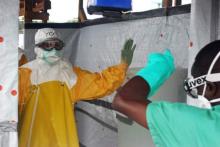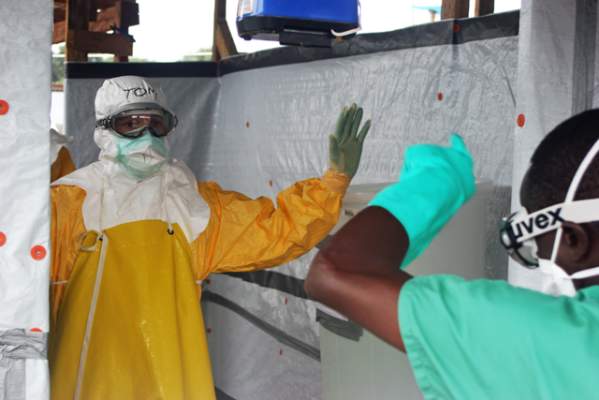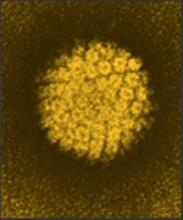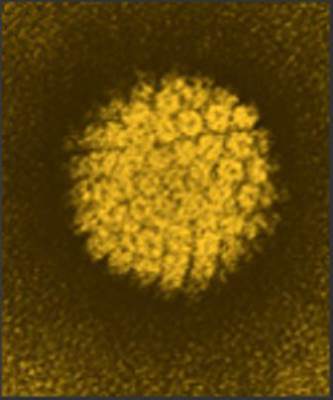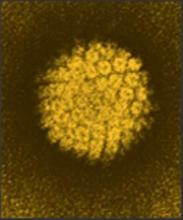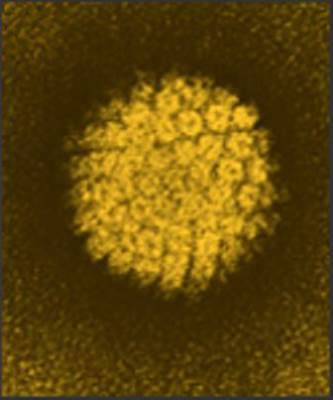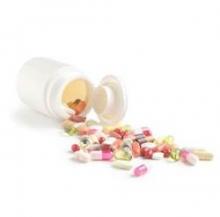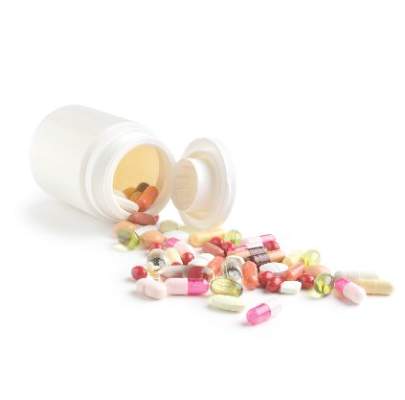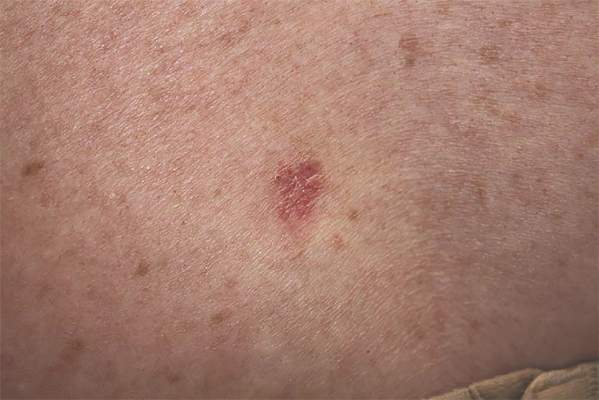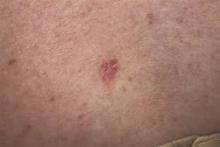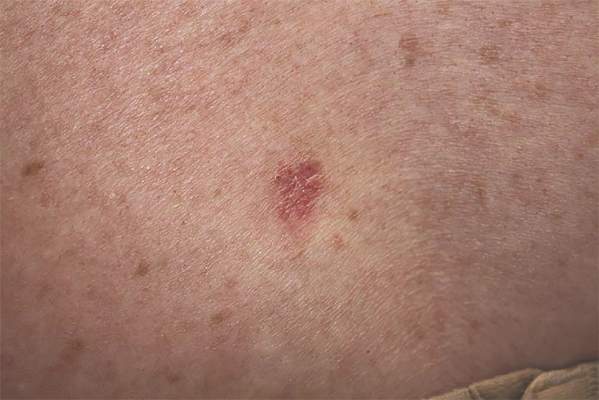User login
IOM report outlines viral outbreak preparedness
Developing medical countermeasures (MCMs) before an emerging infectious disease hits is a ‘national security imperative,’ according to an Institute of Medicine Workshop Summary, and global health security strategies that effectively utilize public-private partnerships should be a top priority for health professionals and governments.
The IOM and several of its partner organizations coconvened a workshop panel on “Rapid Medical Countermeasure Response to Infectious Diseases: Enabling Sustainable Capabilities through Ongoing Public- and Private-Sector Partnerships,” in Washington on March 26-27, 2015. Meeting minutes are available online at the IOM website. The organization recently released a summary report on the panel’s discussions.
Although the panelist’s discussions do not officially reflect the conclusions of the IOM, participants at the workshop discussed the nation’s capacity to provide rapid access to MCMs when infectious disease outbreaks occur. Other topics discussed included preparedness gaps, the sustainability of public-private partnerships, case studies of past incidents of emerging threats such as influenza and coronaviruses, and lessons learned from the Ebola outbreak of 2014.
“Between events such as H1N1 influenza outbreaks, mission capabilities need to be sustained so capacity is not lost when the next event emerges. Additionally, many regulations and policies have been developed in response to past events, instead of looking forward to potential future needs and creating capabilities and partnerships in a systematic matter,” the report summary noted.
To read the full summary report, click here.
Developing medical countermeasures (MCMs) before an emerging infectious disease hits is a ‘national security imperative,’ according to an Institute of Medicine Workshop Summary, and global health security strategies that effectively utilize public-private partnerships should be a top priority for health professionals and governments.
The IOM and several of its partner organizations coconvened a workshop panel on “Rapid Medical Countermeasure Response to Infectious Diseases: Enabling Sustainable Capabilities through Ongoing Public- and Private-Sector Partnerships,” in Washington on March 26-27, 2015. Meeting minutes are available online at the IOM website. The organization recently released a summary report on the panel’s discussions.
Although the panelist’s discussions do not officially reflect the conclusions of the IOM, participants at the workshop discussed the nation’s capacity to provide rapid access to MCMs when infectious disease outbreaks occur. Other topics discussed included preparedness gaps, the sustainability of public-private partnerships, case studies of past incidents of emerging threats such as influenza and coronaviruses, and lessons learned from the Ebola outbreak of 2014.
“Between events such as H1N1 influenza outbreaks, mission capabilities need to be sustained so capacity is not lost when the next event emerges. Additionally, many regulations and policies have been developed in response to past events, instead of looking forward to potential future needs and creating capabilities and partnerships in a systematic matter,” the report summary noted.
To read the full summary report, click here.
Developing medical countermeasures (MCMs) before an emerging infectious disease hits is a ‘national security imperative,’ according to an Institute of Medicine Workshop Summary, and global health security strategies that effectively utilize public-private partnerships should be a top priority for health professionals and governments.
The IOM and several of its partner organizations coconvened a workshop panel on “Rapid Medical Countermeasure Response to Infectious Diseases: Enabling Sustainable Capabilities through Ongoing Public- and Private-Sector Partnerships,” in Washington on March 26-27, 2015. Meeting minutes are available online at the IOM website. The organization recently released a summary report on the panel’s discussions.
Although the panelist’s discussions do not officially reflect the conclusions of the IOM, participants at the workshop discussed the nation’s capacity to provide rapid access to MCMs when infectious disease outbreaks occur. Other topics discussed included preparedness gaps, the sustainability of public-private partnerships, case studies of past incidents of emerging threats such as influenza and coronaviruses, and lessons learned from the Ebola outbreak of 2014.
“Between events such as H1N1 influenza outbreaks, mission capabilities need to be sustained so capacity is not lost when the next event emerges. Additionally, many regulations and policies have been developed in response to past events, instead of looking forward to potential future needs and creating capabilities and partnerships in a systematic matter,” the report summary noted.
To read the full summary report, click here.
BCG slows bladder cancer progression
Bacillus Calmette-Guérin (BCG) is the only intravesical therapy shown to be associated with decreased risk of bladder cancer progression, according to a report by the Agency for Healthcare Research and Quality (AHRQ), but the researchers cautioned that the therapy was associated with a high rate of adverse events.
The Comparative Effectiveness Review, headed by Dr. Roger Chou and based on research by the Pacific Northwest Evidence-Based Practice Center (EPC) under contract to the AHRQ, was conducted as a systematic review of trials identified via electronic databases and conducted from 1990 to 2014.
BCG was associated with a higher rate of local and systemic adverse events (granulomatous cystitis or irritative symptoms in 27%-84% of patients, macroscopic hematuria in 21%-72%, and fever in 27%-44%) when compared with no intravesical therapy, the researchers wrote. BCG was associated with decreased risk of bladder cancer progression, but no intravesical agent was associated with decreased risk of all-cause or bladder cancer mortality.
In addition, fluorescent cystoscopy was associated with decreased risk of subsequent bladder recurrence, compared with white light cystoscopy, but results were inconsistent through many of the trials identified.
Read the full report here.
Bacillus Calmette-Guérin (BCG) is the only intravesical therapy shown to be associated with decreased risk of bladder cancer progression, according to a report by the Agency for Healthcare Research and Quality (AHRQ), but the researchers cautioned that the therapy was associated with a high rate of adverse events.
The Comparative Effectiveness Review, headed by Dr. Roger Chou and based on research by the Pacific Northwest Evidence-Based Practice Center (EPC) under contract to the AHRQ, was conducted as a systematic review of trials identified via electronic databases and conducted from 1990 to 2014.
BCG was associated with a higher rate of local and systemic adverse events (granulomatous cystitis or irritative symptoms in 27%-84% of patients, macroscopic hematuria in 21%-72%, and fever in 27%-44%) when compared with no intravesical therapy, the researchers wrote. BCG was associated with decreased risk of bladder cancer progression, but no intravesical agent was associated with decreased risk of all-cause or bladder cancer mortality.
In addition, fluorescent cystoscopy was associated with decreased risk of subsequent bladder recurrence, compared with white light cystoscopy, but results were inconsistent through many of the trials identified.
Read the full report here.
Bacillus Calmette-Guérin (BCG) is the only intravesical therapy shown to be associated with decreased risk of bladder cancer progression, according to a report by the Agency for Healthcare Research and Quality (AHRQ), but the researchers cautioned that the therapy was associated with a high rate of adverse events.
The Comparative Effectiveness Review, headed by Dr. Roger Chou and based on research by the Pacific Northwest Evidence-Based Practice Center (EPC) under contract to the AHRQ, was conducted as a systematic review of trials identified via electronic databases and conducted from 1990 to 2014.
BCG was associated with a higher rate of local and systemic adverse events (granulomatous cystitis or irritative symptoms in 27%-84% of patients, macroscopic hematuria in 21%-72%, and fever in 27%-44%) when compared with no intravesical therapy, the researchers wrote. BCG was associated with decreased risk of bladder cancer progression, but no intravesical agent was associated with decreased risk of all-cause or bladder cancer mortality.
In addition, fluorescent cystoscopy was associated with decreased risk of subsequent bladder recurrence, compared with white light cystoscopy, but results were inconsistent through many of the trials identified.
Read the full report here.
HPV Vaccine Uptake Rising, But Still Low for Male Teens
About one-third of male teens in the United States reported receiving at least one dose of human papillomavirus vaccine, and only 13.9% received a complete series of three doses of the vaccine, although coverage among male adolescents significantly increased from 2010 to 2013, a study showed.*
Dr. Peng-jun Lu of the Centers for Disease Control and Prevention and his associates used data from the 2013 National Immunization Survey–Teen, a national, random-digit-dial telephone survey sponsored by the CDC, to gather information from 6,039 adolescents between the ages of 13 and 17 years. They found coverage of greater than or equal to one dose was significantly higher among non-Hispanic blacks (42.2%) and Hispanics (49.6%), compared with non-Hispanic whites (26.7%). Similarly, human papillomavirus (HPV) vaccination coverage of three or more doses was significantly higher among non-Hispanic blacks (15.7%) and Hispanics (20.3%), compared with non-Hispanic whites (11.1%).
Parents who did not have their sons receive any HPV vaccinations commonly thought that the provider did not recommend them (24.0%), believed that the vaccinations were not needed or not necessary (18.9%), and had a general lack of knowledge (16.4%), the authors reported.
“To further increase HPV vaccination coverage … efforts should be directed to provide comprehensive, accessible, and appropriate communication messages on HPV and HPV vaccine directed to male adolescents and parents,” the researchers concluded.
Read the full article in Pediatrics (doi: 10.1542/peds.2015-1631).
*Correction, 11/4/2015: An earlier version of this story misstated the number of doses of the vaccine received by the study participants. A total of 34.6% reported receiving at least one dose.
About one-third of male teens in the United States reported receiving at least one dose of human papillomavirus vaccine, and only 13.9% received a complete series of three doses of the vaccine, although coverage among male adolescents significantly increased from 2010 to 2013, a study showed.*
Dr. Peng-jun Lu of the Centers for Disease Control and Prevention and his associates used data from the 2013 National Immunization Survey–Teen, a national, random-digit-dial telephone survey sponsored by the CDC, to gather information from 6,039 adolescents between the ages of 13 and 17 years. They found coverage of greater than or equal to one dose was significantly higher among non-Hispanic blacks (42.2%) and Hispanics (49.6%), compared with non-Hispanic whites (26.7%). Similarly, human papillomavirus (HPV) vaccination coverage of three or more doses was significantly higher among non-Hispanic blacks (15.7%) and Hispanics (20.3%), compared with non-Hispanic whites (11.1%).
Parents who did not have their sons receive any HPV vaccinations commonly thought that the provider did not recommend them (24.0%), believed that the vaccinations were not needed or not necessary (18.9%), and had a general lack of knowledge (16.4%), the authors reported.
“To further increase HPV vaccination coverage … efforts should be directed to provide comprehensive, accessible, and appropriate communication messages on HPV and HPV vaccine directed to male adolescents and parents,” the researchers concluded.
Read the full article in Pediatrics (doi: 10.1542/peds.2015-1631).
*Correction, 11/4/2015: An earlier version of this story misstated the number of doses of the vaccine received by the study participants. A total of 34.6% reported receiving at least one dose.
About one-third of male teens in the United States reported receiving at least one dose of human papillomavirus vaccine, and only 13.9% received a complete series of three doses of the vaccine, although coverage among male adolescents significantly increased from 2010 to 2013, a study showed.*
Dr. Peng-jun Lu of the Centers for Disease Control and Prevention and his associates used data from the 2013 National Immunization Survey–Teen, a national, random-digit-dial telephone survey sponsored by the CDC, to gather information from 6,039 adolescents between the ages of 13 and 17 years. They found coverage of greater than or equal to one dose was significantly higher among non-Hispanic blacks (42.2%) and Hispanics (49.6%), compared with non-Hispanic whites (26.7%). Similarly, human papillomavirus (HPV) vaccination coverage of three or more doses was significantly higher among non-Hispanic blacks (15.7%) and Hispanics (20.3%), compared with non-Hispanic whites (11.1%).
Parents who did not have their sons receive any HPV vaccinations commonly thought that the provider did not recommend them (24.0%), believed that the vaccinations were not needed or not necessary (18.9%), and had a general lack of knowledge (16.4%), the authors reported.
“To further increase HPV vaccination coverage … efforts should be directed to provide comprehensive, accessible, and appropriate communication messages on HPV and HPV vaccine directed to male adolescents and parents,” the researchers concluded.
Read the full article in Pediatrics (doi: 10.1542/peds.2015-1631).
*Correction, 11/4/2015: An earlier version of this story misstated the number of doses of the vaccine received by the study participants. A total of 34.6% reported receiving at least one dose.
FROM PEDIATRICS
HPV vaccine uptake rising, but still low for male teens
About one-third of male teens in the United States reported receiving at least one dose of human papillomavirus vaccine, and only 13.9% received a complete series of three doses of the vaccine, although coverage among male adolescents significantly increased from 2010 to 2013, a study showed.*
Dr. Peng-jun Lu of the Centers for Disease Control and Prevention and his associates used data from the 2013 National Immunization Survey–Teen, a national, random-digit-dial telephone survey sponsored by the CDC, to gather information from 6,039 adolescents between the ages of 13 and 17 years. They found coverage of greater than or equal to one dose was significantly higher among non-Hispanic blacks (42.2%) and Hispanics (49.6%), compared with non-Hispanic whites (26.7%). Similarly, human papillomavirus (HPV) vaccination coverage of three or more doses was significantly higher among non-Hispanic blacks (15.7%) and Hispanics (20.3%), compared with non-Hispanic whites (11.1%).
Parents who did not have their sons receive any HPV vaccinations commonly thought that the provider did not recommend them (24.0%), believed that the vaccinations were not needed or not necessary (18.9%), and had a general lack of knowledge (16.4%), the authors reported.
“To further increase HPV vaccination coverage … efforts should be directed to provide comprehensive, accessible, and appropriate communication messages on HPV and HPV vaccine directed to male adolescents and parents,” the researchers concluded.
Read the full article in Pediatrics (doi: 10.1542/peds.2015-1631).
*Correction, 11/4/2015: An earlier version of this story misstated the number of doses of the vaccine received by the study participants. A total of 34.6% reported receiving at least one dose.
About one-third of male teens in the United States reported receiving at least one dose of human papillomavirus vaccine, and only 13.9% received a complete series of three doses of the vaccine, although coverage among male adolescents significantly increased from 2010 to 2013, a study showed.*
Dr. Peng-jun Lu of the Centers for Disease Control and Prevention and his associates used data from the 2013 National Immunization Survey–Teen, a national, random-digit-dial telephone survey sponsored by the CDC, to gather information from 6,039 adolescents between the ages of 13 and 17 years. They found coverage of greater than or equal to one dose was significantly higher among non-Hispanic blacks (42.2%) and Hispanics (49.6%), compared with non-Hispanic whites (26.7%). Similarly, human papillomavirus (HPV) vaccination coverage of three or more doses was significantly higher among non-Hispanic blacks (15.7%) and Hispanics (20.3%), compared with non-Hispanic whites (11.1%).
Parents who did not have their sons receive any HPV vaccinations commonly thought that the provider did not recommend them (24.0%), believed that the vaccinations were not needed or not necessary (18.9%), and had a general lack of knowledge (16.4%), the authors reported.
“To further increase HPV vaccination coverage … efforts should be directed to provide comprehensive, accessible, and appropriate communication messages on HPV and HPV vaccine directed to male adolescents and parents,” the researchers concluded.
Read the full article in Pediatrics (doi: 10.1542/peds.2015-1631).
*Correction, 11/4/2015: An earlier version of this story misstated the number of doses of the vaccine received by the study participants. A total of 34.6% reported receiving at least one dose.
About one-third of male teens in the United States reported receiving at least one dose of human papillomavirus vaccine, and only 13.9% received a complete series of three doses of the vaccine, although coverage among male adolescents significantly increased from 2010 to 2013, a study showed.*
Dr. Peng-jun Lu of the Centers for Disease Control and Prevention and his associates used data from the 2013 National Immunization Survey–Teen, a national, random-digit-dial telephone survey sponsored by the CDC, to gather information from 6,039 adolescents between the ages of 13 and 17 years. They found coverage of greater than or equal to one dose was significantly higher among non-Hispanic blacks (42.2%) and Hispanics (49.6%), compared with non-Hispanic whites (26.7%). Similarly, human papillomavirus (HPV) vaccination coverage of three or more doses was significantly higher among non-Hispanic blacks (15.7%) and Hispanics (20.3%), compared with non-Hispanic whites (11.1%).
Parents who did not have their sons receive any HPV vaccinations commonly thought that the provider did not recommend them (24.0%), believed that the vaccinations were not needed or not necessary (18.9%), and had a general lack of knowledge (16.4%), the authors reported.
“To further increase HPV vaccination coverage … efforts should be directed to provide comprehensive, accessible, and appropriate communication messages on HPV and HPV vaccine directed to male adolescents and parents,” the researchers concluded.
Read the full article in Pediatrics (doi: 10.1542/peds.2015-1631).
*Correction, 11/4/2015: An earlier version of this story misstated the number of doses of the vaccine received by the study participants. A total of 34.6% reported receiving at least one dose.
FROM PEDIATRICS
Opioid abuse more prevalent in females with major depression
Females with major depressive episodes are more likely than are males to report past-year comorbid nonmedical use of prescription opioids, according to research published in Drug and Alcohol Dependence.
In addition, past-year drug abuse is strongly associated with both nonmedical use of prescription opioids (NMUPO) and major depressive episodes (MDE) in both females and males, reported epidemiologist David S. Fink and his associates.
Almost twice the proportion of women, compared with men, reported both MDE-alone and comorbid NMUPO and MDE. However, a higher proportion of males, compared with females, reported NMUPO-alone. In addition, NMUPO and MDE were significantly more common among people who were unemployed and those who reported lower annual family income, noted Mr. Fink, a PhD candidate at Columbia University, New York.
Among adolescent and adult respondents, 5.8% and 4.5%, respectively, reported any past-year NMUPO, while 8.6% of adolescents and 6.8% of adults met criteria for past-year MDE. The overall prevalence of comorbid NMUPO and MDE was 1.2% and 0.7% among adolescent and adult respondents, respectively. Data for the analysis came from the 2011 (n = 58,397) and 2012 (n = 55,268) National Survey on Drug Use and Health public use files. Cases of MDE were defined using DSM-IV criteria, and NMUPO history was based on self-reported data (Drug Alcohol Depend. 2015 Aug 1;153:258-64).
“This finding highlights a need for interventions to target both high-risk polydrug users and population level interventions to ameliorate misuse of prescription opioids,” the investigators concluded.
Read the full article here.
Females with major depressive episodes are more likely than are males to report past-year comorbid nonmedical use of prescription opioids, according to research published in Drug and Alcohol Dependence.
In addition, past-year drug abuse is strongly associated with both nonmedical use of prescription opioids (NMUPO) and major depressive episodes (MDE) in both females and males, reported epidemiologist David S. Fink and his associates.
Almost twice the proportion of women, compared with men, reported both MDE-alone and comorbid NMUPO and MDE. However, a higher proportion of males, compared with females, reported NMUPO-alone. In addition, NMUPO and MDE were significantly more common among people who were unemployed and those who reported lower annual family income, noted Mr. Fink, a PhD candidate at Columbia University, New York.
Among adolescent and adult respondents, 5.8% and 4.5%, respectively, reported any past-year NMUPO, while 8.6% of adolescents and 6.8% of adults met criteria for past-year MDE. The overall prevalence of comorbid NMUPO and MDE was 1.2% and 0.7% among adolescent and adult respondents, respectively. Data for the analysis came from the 2011 (n = 58,397) and 2012 (n = 55,268) National Survey on Drug Use and Health public use files. Cases of MDE were defined using DSM-IV criteria, and NMUPO history was based on self-reported data (Drug Alcohol Depend. 2015 Aug 1;153:258-64).
“This finding highlights a need for interventions to target both high-risk polydrug users and population level interventions to ameliorate misuse of prescription opioids,” the investigators concluded.
Read the full article here.
Females with major depressive episodes are more likely than are males to report past-year comorbid nonmedical use of prescription opioids, according to research published in Drug and Alcohol Dependence.
In addition, past-year drug abuse is strongly associated with both nonmedical use of prescription opioids (NMUPO) and major depressive episodes (MDE) in both females and males, reported epidemiologist David S. Fink and his associates.
Almost twice the proportion of women, compared with men, reported both MDE-alone and comorbid NMUPO and MDE. However, a higher proportion of males, compared with females, reported NMUPO-alone. In addition, NMUPO and MDE were significantly more common among people who were unemployed and those who reported lower annual family income, noted Mr. Fink, a PhD candidate at Columbia University, New York.
Among adolescent and adult respondents, 5.8% and 4.5%, respectively, reported any past-year NMUPO, while 8.6% of adolescents and 6.8% of adults met criteria for past-year MDE. The overall prevalence of comorbid NMUPO and MDE was 1.2% and 0.7% among adolescent and adult respondents, respectively. Data for the analysis came from the 2011 (n = 58,397) and 2012 (n = 55,268) National Survey on Drug Use and Health public use files. Cases of MDE were defined using DSM-IV criteria, and NMUPO history was based on self-reported data (Drug Alcohol Depend. 2015 Aug 1;153:258-64).
“This finding highlights a need for interventions to target both high-risk polydrug users and population level interventions to ameliorate misuse of prescription opioids,” the investigators concluded.
Read the full article here.
FROM DRUG AND ALCOHOL DEPENDENCE
MDQ screen useful tool for bipolar on inpatient units
When screening for bipolar disorders, Mood Disorders Questionnaire scores proved more sensitive – but showed less specificity – in an inpatient mood disorders setting than an outpatient psychiatric population, a retrospective study shows. The results suggest that the MDQ can be used effectively on an inpatient psychiatry mood disorders unit, reported Dr. Simon Kung and his associates.
Dr. Kung of the Mayo Clinic in Rochester, Minn., and his associates evaluated 1,330 patients who checked into a mood disorders unit and administered the MDQ upon entry. After excluding patients with diagnoses that were neither unipolar or bipolar, 860 MDQs were ultimately used. Sensitivity and specificity were calculated for each number of questionnaire items checked positive.
The researchers determined that the optimal cutoff score for MDQs was 8, resulting in a sensitivity/specificity of 86%/71%, compared with 92%/64% using the recommended outpatient cutoff of 7.
Read the full article here: (J Affect Disord. 201515;188:97-100. doi:10.1016/j.jad.2015.08.060)
When screening for bipolar disorders, Mood Disorders Questionnaire scores proved more sensitive – but showed less specificity – in an inpatient mood disorders setting than an outpatient psychiatric population, a retrospective study shows. The results suggest that the MDQ can be used effectively on an inpatient psychiatry mood disorders unit, reported Dr. Simon Kung and his associates.
Dr. Kung of the Mayo Clinic in Rochester, Minn., and his associates evaluated 1,330 patients who checked into a mood disorders unit and administered the MDQ upon entry. After excluding patients with diagnoses that were neither unipolar or bipolar, 860 MDQs were ultimately used. Sensitivity and specificity were calculated for each number of questionnaire items checked positive.
The researchers determined that the optimal cutoff score for MDQs was 8, resulting in a sensitivity/specificity of 86%/71%, compared with 92%/64% using the recommended outpatient cutoff of 7.
Read the full article here: (J Affect Disord. 201515;188:97-100. doi:10.1016/j.jad.2015.08.060)
When screening for bipolar disorders, Mood Disorders Questionnaire scores proved more sensitive – but showed less specificity – in an inpatient mood disorders setting than an outpatient psychiatric population, a retrospective study shows. The results suggest that the MDQ can be used effectively on an inpatient psychiatry mood disorders unit, reported Dr. Simon Kung and his associates.
Dr. Kung of the Mayo Clinic in Rochester, Minn., and his associates evaluated 1,330 patients who checked into a mood disorders unit and administered the MDQ upon entry. After excluding patients with diagnoses that were neither unipolar or bipolar, 860 MDQs were ultimately used. Sensitivity and specificity were calculated for each number of questionnaire items checked positive.
The researchers determined that the optimal cutoff score for MDQs was 8, resulting in a sensitivity/specificity of 86%/71%, compared with 92%/64% using the recommended outpatient cutoff of 7.
Read the full article here: (J Affect Disord. 201515;188:97-100. doi:10.1016/j.jad.2015.08.060)
FROM THE JOURNAL OF AFFECTIVE DISORDERS
Nonmelanoma Skin Cancer Initially Misdiagnosed in 36% of Small Cohort
In a small sample study, 10 (36%) of 28 children and young adults diagnosed with nonmelanoma skin cancer were given a misdiagnosis initially, suggesting that young patients with NMSC risk factors may require heightened monitoring from health care providers, according to a study published in Journal of the American Academy of Dermatology (2015 doi: 10.1016/j.jaad.2015.08.007).
In their efforts to identify potential risk factors and gaps in care associated with NMSC in pediatric populations, lead author Hasan Khosravi of Harvard Medical School, Boston, and his associates examined records from 28 patients and 182 occurrences of NMSC, collected from Boston Children’s Hospital between 1993 and 2014.
Thirteen (46%) of the 28 pediatric NMSC patients had a history of prolonged immunosuppression, radiation therapy, chemotherapy, voriconazole use, or a combination of these. Among these 28 patients, 19 were diagnosed with basal cell carcinoma (BCC), 7 were diagnosed with squamous cell carcinoma (SCC), and 2 were diagnosed with both BCC and SCC.
The authors noted significant delays in the initial diagnosis in both types of cancer; the mean number of days from time of lesion onset to diagnosis was 667 for SCC and 1,176 for BCC. When misdiagnosed, carcinomas were incorrectly identified as viral wart and graft-versus-host disease for SCC, and psoriasis, acrochordon, wart, nevus, and atypical nevus for BCC.
Even so, interventions were effective in the pediatric population, the authors noted.
“Although most of our patients developed subsequent NMSC after their initial diagnosis, the majority of cases were treated successfully with surgical excision, without recurrence or spread of disease. This suggests that interventions in children and young adults that involve prevention of subsequent disease may be most impactful,” they wrote.
The researchers had no conflicts to declare.
In a small sample study, 10 (36%) of 28 children and young adults diagnosed with nonmelanoma skin cancer were given a misdiagnosis initially, suggesting that young patients with NMSC risk factors may require heightened monitoring from health care providers, according to a study published in Journal of the American Academy of Dermatology (2015 doi: 10.1016/j.jaad.2015.08.007).
In their efforts to identify potential risk factors and gaps in care associated with NMSC in pediatric populations, lead author Hasan Khosravi of Harvard Medical School, Boston, and his associates examined records from 28 patients and 182 occurrences of NMSC, collected from Boston Children’s Hospital between 1993 and 2014.
Thirteen (46%) of the 28 pediatric NMSC patients had a history of prolonged immunosuppression, radiation therapy, chemotherapy, voriconazole use, or a combination of these. Among these 28 patients, 19 were diagnosed with basal cell carcinoma (BCC), 7 were diagnosed with squamous cell carcinoma (SCC), and 2 were diagnosed with both BCC and SCC.
The authors noted significant delays in the initial diagnosis in both types of cancer; the mean number of days from time of lesion onset to diagnosis was 667 for SCC and 1,176 for BCC. When misdiagnosed, carcinomas were incorrectly identified as viral wart and graft-versus-host disease for SCC, and psoriasis, acrochordon, wart, nevus, and atypical nevus for BCC.
Even so, interventions were effective in the pediatric population, the authors noted.
“Although most of our patients developed subsequent NMSC after their initial diagnosis, the majority of cases were treated successfully with surgical excision, without recurrence or spread of disease. This suggests that interventions in children and young adults that involve prevention of subsequent disease may be most impactful,” they wrote.
The researchers had no conflicts to declare.
In a small sample study, 10 (36%) of 28 children and young adults diagnosed with nonmelanoma skin cancer were given a misdiagnosis initially, suggesting that young patients with NMSC risk factors may require heightened monitoring from health care providers, according to a study published in Journal of the American Academy of Dermatology (2015 doi: 10.1016/j.jaad.2015.08.007).
In their efforts to identify potential risk factors and gaps in care associated with NMSC in pediatric populations, lead author Hasan Khosravi of Harvard Medical School, Boston, and his associates examined records from 28 patients and 182 occurrences of NMSC, collected from Boston Children’s Hospital between 1993 and 2014.
Thirteen (46%) of the 28 pediatric NMSC patients had a history of prolonged immunosuppression, radiation therapy, chemotherapy, voriconazole use, or a combination of these. Among these 28 patients, 19 were diagnosed with basal cell carcinoma (BCC), 7 were diagnosed with squamous cell carcinoma (SCC), and 2 were diagnosed with both BCC and SCC.
The authors noted significant delays in the initial diagnosis in both types of cancer; the mean number of days from time of lesion onset to diagnosis was 667 for SCC and 1,176 for BCC. When misdiagnosed, carcinomas were incorrectly identified as viral wart and graft-versus-host disease for SCC, and psoriasis, acrochordon, wart, nevus, and atypical nevus for BCC.
Even so, interventions were effective in the pediatric population, the authors noted.
“Although most of our patients developed subsequent NMSC after their initial diagnosis, the majority of cases were treated successfully with surgical excision, without recurrence or spread of disease. This suggests that interventions in children and young adults that involve prevention of subsequent disease may be most impactful,” they wrote.
The researchers had no conflicts to declare.
FROM JOURNAL OF THE AMERICAN ACADEMY OF DERMATOLOGY
Nonmelanoma skin cancer initially misdiagnosed in 36% of small cohort
In a small sample study, 10 (36%) of 28 children and young adults diagnosed with nonmelanoma skin cancer were given a misdiagnosis initially, suggesting that young patients with NMSC risk factors may require heightened monitoring from health care providers, according to a study published in Journal of the American Academy of Dermatology (2015 doi: 10.1016/j.jaad.2015.08.007).
In their efforts to identify potential risk factors and gaps in care associated with NMSC in pediatric populations, lead author Hasan Khosravi of Harvard Medical School, Boston, and his associates examined records from 28 patients and 182 occurrences of NMSC, collected from Boston Children’s Hospital between 1993 and 2014.
Thirteen (46%) of the 28 pediatric NMSC patients had a history of prolonged immunosuppression, radiation therapy, chemotherapy, voriconazole use, or a combination of these. Among these 28 patients, 19 were diagnosed with basal cell carcinoma (BCC), 7 were diagnosed with squamous cell carcinoma (SCC), and 2 were diagnosed with both BCC and SCC.
The authors noted significant delays in the initial diagnosis in both types of cancer; the mean number of days from time of lesion onset to diagnosis was 667 for SCC and 1,176 for BCC. When misdiagnosed, carcinomas were incorrectly identified as viral wart and graft-versus-host disease for SCC, and psoriasis, acrochordon, wart, nevus, and atypical nevus for BCC.
Even so, interventions were effective in the pediatric population, the authors noted.
“Although most of our patients developed subsequent NMSC after their initial diagnosis, the majority of cases were treated successfully with surgical excision, without recurrence or spread of disease. This suggests that interventions in children and young adults that involve prevention of subsequent disease may be most impactful,” they wrote.
The researchers had no conflicts to declare.
In a small sample study, 10 (36%) of 28 children and young adults diagnosed with nonmelanoma skin cancer were given a misdiagnosis initially, suggesting that young patients with NMSC risk factors may require heightened monitoring from health care providers, according to a study published in Journal of the American Academy of Dermatology (2015 doi: 10.1016/j.jaad.2015.08.007).
In their efforts to identify potential risk factors and gaps in care associated with NMSC in pediatric populations, lead author Hasan Khosravi of Harvard Medical School, Boston, and his associates examined records from 28 patients and 182 occurrences of NMSC, collected from Boston Children’s Hospital between 1993 and 2014.
Thirteen (46%) of the 28 pediatric NMSC patients had a history of prolonged immunosuppression, radiation therapy, chemotherapy, voriconazole use, or a combination of these. Among these 28 patients, 19 were diagnosed with basal cell carcinoma (BCC), 7 were diagnosed with squamous cell carcinoma (SCC), and 2 were diagnosed with both BCC and SCC.
The authors noted significant delays in the initial diagnosis in both types of cancer; the mean number of days from time of lesion onset to diagnosis was 667 for SCC and 1,176 for BCC. When misdiagnosed, carcinomas were incorrectly identified as viral wart and graft-versus-host disease for SCC, and psoriasis, acrochordon, wart, nevus, and atypical nevus for BCC.
Even so, interventions were effective in the pediatric population, the authors noted.
“Although most of our patients developed subsequent NMSC after their initial diagnosis, the majority of cases were treated successfully with surgical excision, without recurrence or spread of disease. This suggests that interventions in children and young adults that involve prevention of subsequent disease may be most impactful,” they wrote.
The researchers had no conflicts to declare.
In a small sample study, 10 (36%) of 28 children and young adults diagnosed with nonmelanoma skin cancer were given a misdiagnosis initially, suggesting that young patients with NMSC risk factors may require heightened monitoring from health care providers, according to a study published in Journal of the American Academy of Dermatology (2015 doi: 10.1016/j.jaad.2015.08.007).
In their efforts to identify potential risk factors and gaps in care associated with NMSC in pediatric populations, lead author Hasan Khosravi of Harvard Medical School, Boston, and his associates examined records from 28 patients and 182 occurrences of NMSC, collected from Boston Children’s Hospital between 1993 and 2014.
Thirteen (46%) of the 28 pediatric NMSC patients had a history of prolonged immunosuppression, radiation therapy, chemotherapy, voriconazole use, or a combination of these. Among these 28 patients, 19 were diagnosed with basal cell carcinoma (BCC), 7 were diagnosed with squamous cell carcinoma (SCC), and 2 were diagnosed with both BCC and SCC.
The authors noted significant delays in the initial diagnosis in both types of cancer; the mean number of days from time of lesion onset to diagnosis was 667 for SCC and 1,176 for BCC. When misdiagnosed, carcinomas were incorrectly identified as viral wart and graft-versus-host disease for SCC, and psoriasis, acrochordon, wart, nevus, and atypical nevus for BCC.
Even so, interventions were effective in the pediatric population, the authors noted.
“Although most of our patients developed subsequent NMSC after their initial diagnosis, the majority of cases were treated successfully with surgical excision, without recurrence or spread of disease. This suggests that interventions in children and young adults that involve prevention of subsequent disease may be most impactful,” they wrote.
The researchers had no conflicts to declare.
FROM JOURNAL OF THE AMERICAN ACADEMY OF DERMATOLOGY
Bipolar patients, relatives slow to gauge facial emotions
Both bipolar disorder (BD) patients and their first-degree relatives were slower than were healthy controls in an emotion recognition task, suggesting facial recognition may be an endophenotype in bipolar disorder, according to a study published in Psychiatry Research.
Dr. Esther Vierck of the University of Otago in New Zealand and her associates compared 36 BD patients and 40 healthy control participants in a computerized facial emotion recognition task – 24 of the BD patient group’s first-degree relatives also were measured.
The researchers noted that bipolar patients were less accurate in recognizing emotional expressions than were controls, but did not find any evidence for emotion specificity within the BD or BD relative groups.
Read the article here: doi:10.1016/j.psychres.2015.08.033.
Both bipolar disorder (BD) patients and their first-degree relatives were slower than were healthy controls in an emotion recognition task, suggesting facial recognition may be an endophenotype in bipolar disorder, according to a study published in Psychiatry Research.
Dr. Esther Vierck of the University of Otago in New Zealand and her associates compared 36 BD patients and 40 healthy control participants in a computerized facial emotion recognition task – 24 of the BD patient group’s first-degree relatives also were measured.
The researchers noted that bipolar patients were less accurate in recognizing emotional expressions than were controls, but did not find any evidence for emotion specificity within the BD or BD relative groups.
Read the article here: doi:10.1016/j.psychres.2015.08.033.
Both bipolar disorder (BD) patients and their first-degree relatives were slower than were healthy controls in an emotion recognition task, suggesting facial recognition may be an endophenotype in bipolar disorder, according to a study published in Psychiatry Research.
Dr. Esther Vierck of the University of Otago in New Zealand and her associates compared 36 BD patients and 40 healthy control participants in a computerized facial emotion recognition task – 24 of the BD patient group’s first-degree relatives also were measured.
The researchers noted that bipolar patients were less accurate in recognizing emotional expressions than were controls, but did not find any evidence for emotion specificity within the BD or BD relative groups.
Read the article here: doi:10.1016/j.psychres.2015.08.033.
FROM PSYCHIATRY RESEARCH
Lithium safe, effective for kids with bipolar type I
Lithium appears to be both safe and effective for the management of bipolar I disorder symptoms in pediatric populations, a recently published study from Pediatrics confirms.
Lead author Dr. Robert L. Findling of Johns Hopkins University and his associates conducted a multicenter, randomized, placebo-controlled outpatient trial, gathering data from 153 participants between the ages of 7 and 17 with bipolar I disorder/manic or mixed episodes. Among the participants, 81 were randomized to receive lithium (n = 53) or placebo (n = 28), for up to 8 weeks. Symptoms of bipolar disorder were assessed using the Young Mania Rating Scale (YMRS) score.
Ultimately, the study found that lithium was effective in reducing manic symptoms in nearly one-half (47%) of these participants, with Overall Clinical Global Impression–Improvement scores favoring lithium (n = 25; 47% very much/much improved), compared with placebo (n = 6; 21% very much/much improved) after 8 weeks. The researchers also noted that lithium use was not associated with weight gain, although they observed a statistically significant increase in thyrotropin concentration among the lithium group. Nausea, headache, and vomiting were the most common side effects.
“This study provides evidence to support the efficacy of lithium in the acute treatment of youths with [bipolar I disorder] who are currently in a manic or mixed state. Lithium had an adverse effect profile that was acceptable for most patients,” the authors wrote.
Read the full article in Pediatrics.
Lithium appears to be both safe and effective for the management of bipolar I disorder symptoms in pediatric populations, a recently published study from Pediatrics confirms.
Lead author Dr. Robert L. Findling of Johns Hopkins University and his associates conducted a multicenter, randomized, placebo-controlled outpatient trial, gathering data from 153 participants between the ages of 7 and 17 with bipolar I disorder/manic or mixed episodes. Among the participants, 81 were randomized to receive lithium (n = 53) or placebo (n = 28), for up to 8 weeks. Symptoms of bipolar disorder were assessed using the Young Mania Rating Scale (YMRS) score.
Ultimately, the study found that lithium was effective in reducing manic symptoms in nearly one-half (47%) of these participants, with Overall Clinical Global Impression–Improvement scores favoring lithium (n = 25; 47% very much/much improved), compared with placebo (n = 6; 21% very much/much improved) after 8 weeks. The researchers also noted that lithium use was not associated with weight gain, although they observed a statistically significant increase in thyrotropin concentration among the lithium group. Nausea, headache, and vomiting were the most common side effects.
“This study provides evidence to support the efficacy of lithium in the acute treatment of youths with [bipolar I disorder] who are currently in a manic or mixed state. Lithium had an adverse effect profile that was acceptable for most patients,” the authors wrote.
Read the full article in Pediatrics.
Lithium appears to be both safe and effective for the management of bipolar I disorder symptoms in pediatric populations, a recently published study from Pediatrics confirms.
Lead author Dr. Robert L. Findling of Johns Hopkins University and his associates conducted a multicenter, randomized, placebo-controlled outpatient trial, gathering data from 153 participants between the ages of 7 and 17 with bipolar I disorder/manic or mixed episodes. Among the participants, 81 were randomized to receive lithium (n = 53) or placebo (n = 28), for up to 8 weeks. Symptoms of bipolar disorder were assessed using the Young Mania Rating Scale (YMRS) score.
Ultimately, the study found that lithium was effective in reducing manic symptoms in nearly one-half (47%) of these participants, with Overall Clinical Global Impression–Improvement scores favoring lithium (n = 25; 47% very much/much improved), compared with placebo (n = 6; 21% very much/much improved) after 8 weeks. The researchers also noted that lithium use was not associated with weight gain, although they observed a statistically significant increase in thyrotropin concentration among the lithium group. Nausea, headache, and vomiting were the most common side effects.
“This study provides evidence to support the efficacy of lithium in the acute treatment of youths with [bipolar I disorder] who are currently in a manic or mixed state. Lithium had an adverse effect profile that was acceptable for most patients,” the authors wrote.
Read the full article in Pediatrics.
FROM PEDIATRICS
